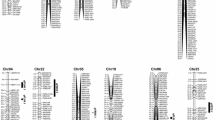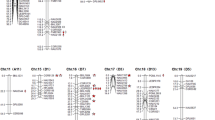Abstract
Cotton cultivars with reduced fiber-seed attachment force have the potential to be ginned faster with less energy. The objective of this study was to identify quantitative trait loci (QTL) for net ginning energy requirement (NGE), and its relationship with other fiber quality traits in upland cotton. Two cotton lines, TAM 182-34 ELS and AR 9317-26, with significant differences in NGE and fiber-seed attachment force, were crossed and 285 F2 plants derived from a single F1 plant were planted in the field and leaf samples collected for DNA marker analysis (Population A). Individual F3 plants and the two parents were planted in replicated progeny rows. The cotton was ginned on a 10-saw laboratory gin stand. Electrical power used by the gin was measured and recorded with a Yokogawa CW121 power meter. Fiber quality attributes were measured using a high volume instrument. A total of 455 SSR marker loci were used to construct a linkage map. Two QTLs were identified for NGE on chromosomes 12 and 20, associated with markers CIR148 and DPL0600, explaining 14 and 8.8% of the phenotypic variation, respectively. NGE shared the same genomic region with fuzz percent on chromosome 12. Population B, consisting of 260 F2 progeny from the reciprocal cross AR 9317-26 X TAM 182-34 ELS, was used to confirm these QTLs by analyzing SSR markers mapped on Chrs 12 and 20. These QTLs (qNGE-c12 and qNGE-c20) were confirmed and appeared stable. Further validation of significantly associated markers on different populations is necessary prior to implementation in marker-assisted selection.


Similar content being viewed by others
Abbreviations
- EL:
-
Elongation
- FL:
-
Fiber length
- FS:
-
Fiber strength
- FZP:
-
Fuzz percent
- GR:
-
Ginning rate
- HVI:
-
High volume instrument
- MIC:
-
Micronaire
- MAS:
-
Marker assisted selection
- NGE:
-
Net ginning energy
- QTL:
-
Quantitative trait loci
- TO:
-
Turnout
- UN:
-
Uniformity
References
Anthony WS, Wesley RA, Brown LG (1982) Dynamic programming model of a cotton ginning system. Trans ASAE. doi:10.13031/2013.33500
Bechere E, Auld D, Hequet E (2009) Development of ‘naked-tufted’ seed coat mutants for potential use in cotton production. Euphytica 167:333–339
Bechere E, Boykin JC, Meredith WR (2011) Evaluation of cotton genotypes for ginning energy and ginning rate. J. Cotton Sci 15:11–21
Bechere E, Boykin JC, Zeng L (2014) Genetics of ginning efficiency and its genotypic and phenotypic correlations with agronomic and fiber traits in upland cotton. Crop Sci 54:507–513
Blenda A, Fang DD, Rami JF, Garsmeur O, Luo F, Lacape JM (2012) A high density consensus genetic map of tetraploid cotton that integrates multiple component maps through molecular marker redundancy check. PLoS ONE 7:e45739
Boykin JC (2007) Cultivar differences in gin stand energy utilization. Trans ASABE 50(3):733–743. doi:10.13031/2013.23128
Boykin JC, Bechere E, Meredith WR (2012) Cotton genotypes differences in fiber-seed attachment force. J. Cotton Sci. 16:170–178
Chapman WE Jr (1969) Strength of attachment of fibers to cotton seeds: Its measurement and importance in ginning and quality of Upland and American-Egyptian cotton. ARS 42-157. USDA Agricultural Research Services, Mesilla Park, NM
Collard BCY, Mackill DJ (2008) Marker-assisted selection: an approach for precision plant breeding in the twenty-first century. Philos Trans R Soc B 365:557–572
Fang DD, Xiao J, Canci PC, Cantrell RG (2010) A new SNP haplotype associated with blue disease resistance gene in cotton (Gossypium hirsutum L.). Theor Appl Genet 120:943–953
Fransen T, Verschraege L, Kalisa P (1984) Measuring cotton fiber to seed attachment force. Cotton Fibers Trop 39:137–143
Griffin AC Jr (1984) Ginning and quality characteristics of cotton with low fiber-to-seed attachment strength. In: Proceedings of the Beltwide Cotton Conference, National Cotton Council of America, Memphis, pp 59–62
ICAC (2009) World cotton area to continue down in 2009/10. http://www.icac.org/cotton_info/publications/press/2009/pc_march_2009.pdf
Kosambi DD (1944) The estimation of map distances from recombination values. Ann Eugen 12:172–175
McCouch SR, Cho YG, Yano PE, Blinstrub M, Morishima H, Kinoshita T (1997) Report on QTL nomenclature. Rice Genet Newsl 14:11–13
Porter MA, Wahba FT (1999) Assessing ginnability of Australian cotton fiber. Trans ASAE 42(4):853–857. doi:10.13031/2013.13263
SAS Institute (2004) SAS/STAT User’s Guide. Version 9.1. SAS Inst., Cary, NC
Smith CW, Hague S, Thaxton PS, Hequet E, Jones D (2009) Registration of eight extra-long staple upland cotton germplasm lines. J Plant Regist 3(1):81–85
Terauchi R, Abe A, Takagi H, Tamiru M, Fekih R, Natsume S, Yaegashi H, Kosugi S, Kanzaki H, Matsumura H, Sanitoh H, Yoshida K, Cano L, Kamoun S (2015) Whole genome sequencing to identify genes and QTLs in rice. In: Sablok G, Kumar S, Ueno S, Kuo J, Varotto C (eds) Advances in the understanding of biological sciences using next generation sequencing (NGS) approaches. Springer, Switzerland, pp 33–42
Valco TD, Ashley H (2008) The cotton ginning industry: past, present and future. In Proceedings of beltwide cotton conferences, Nashville, 8–11 Jan 2008. National Cotton Council of America, Memphis, pp 653–659
Van Ooijen JW (2006) JoinMap 4.0: Software for the calculation of genetic linkage maps in experimental populations. Kyazma B.V., Wageningen, The Netherlands
Van Ooijen JW (2009) MapQTL 6, software for the mapping of quantitative trait loci in experimental populations of diploid species. Kyazma, BV, Wageningen
Verschraege L, Kiekens P (1987) Cotton fiber-to-seed attachment forces. Cotton fibers: their development and properties (2). Technical monograph of the Belgian Cotton Research Group. International Institute for Cotton, Manchester, UK
Acknowledgements
This research is part of the National Program 301 (Plant Genetic Resources, Genomics and Genetic Improvement) and is funded through ARS Project Number 6066-21000-051-00D. Our appreciation goes to Mrs. Sheron Simpson and Dr. Brian Scheffler at the Genomics and Bioinformatics Research Unit at Stoneville, MS for their support in SSR marker analysis. Mention of trade names or commercial products in this article is solely for the purpose of providing specific information and does not imply recommendation or endorsement by the U.S Department of Agriculture, which is an equal opportunity provider and employer.
Author information
Authors and Affiliations
Contributions
EB conceived the experiment, developed the mapping population, grew the F2 and F3 populations, collected and analyzed the phenotypic data and co-wrote the manuscript. DDF scored all PCR plates, supervised the research work at New Orleans. HK conducted the linkage map construction and QTL analysis and wrote the manuscript. BH measured the ginning energy. MI conducted the original marker screening using the two parents. PL isolated DNA and ran all PCR. JS helped in the design of the test and provided critical review of the manuscript.
Corresponding author
Ethics declarations
Conflict of interest
The authors declare that they have no conflict of interest.
Rights and permissions
About this article
Cite this article
Bechere, E., Fang, D.D., Kebede, H. et al. Quantitative trait loci analysis for net ginning energy requirements in upland cotton (Gossypium hirsutum L.). Euphytica 213, 160 (2017). https://doi.org/10.1007/s10681-017-1951-z
Received:
Accepted:
Published:
DOI: https://doi.org/10.1007/s10681-017-1951-z




